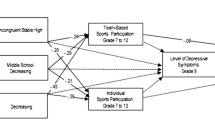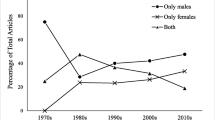Abstract
The present study examined the extent to which childhood play activities predict future sport participation by women. Eighty-four college women (40 Division III varsity athletes and 44 nonathletes) at a predominantly White liberal arts school in the Southwest completed a questionnaire that measured their adult experiences with sports as well as their childhood play activities. The results revealed that playing with “masculine” (rather than “feminine”) toys and games, playing in predominantly male or mixed-gender groups, and being considered a tomboy distinguished between women who later became college athletes and those who did not. These findings suggest that childhood play activities should be considered, along with other agents of socialization (i.e., family, peers, coaches), as important factors in predicting future sport participation by females.
Similar content being viewed by others
REFERENCES
Acosta, R. V., & Carpenter, L. J. (1994). That status of women in intercollegiate athletics.In S. Birrell & C. L. Cole (Eds.), Women, sport, and culture (pp. 111–118). Champaign, IL: Human Kinetics.
Andre, T., & Holland, A. (1995). Relationship of sport participation to sex role orientation and attitudes toward women among high school males and females. Journal of Sport Behavior, 18, 241–253.
Bahrick, H. P., Hall, L. K., & Berger, S. A. (1996). Accuracy and distortion in memory for high school grades. Psychological Science, 7, 265–271.
Bandura, A. (1977). Social learning theory. Englewood Cliffs, NJ: Prentice-Hall.
Bem, S. L. (1974). The measurement of psychological androgyny. Journal of Consulting and Clinical Psychology, 42, 155–162.
Block, J. H. (1982). Psychological development of female children and adolescents. In P. W. Berman & E. R. Ramen (Eds.), Women: A developmental perspective. Bethesda, MD: National Institutes of Mental Health.
Cann, A. (1991). Gender expectations and sports participation. In L. Diamont (Ed.), Psychology of sports, exercise, and fitness: Social and personal issues (pp. 187–214). New York: Hemisphere.
Coakley, J. J. (1987). Children and the sport socialization process. In D. Gould & M. R. Weiss (Eds.), Advances in pediatric sport sciences (pp. 204–210). Champaign, IL: Human Kinetics.
Coakley, J. J., & White, A. (1992). Making decisions: Gender and sport participation among British adolescents. Sociology of Sport Journal, 9, 20–35.
Coats, P. B., & Overman, S. J. (1992). Childhood play experiences of women in traditional and nontraditional professions. Sex Roles, 26, 261–271.
Cohen, J. (1983). The cost of dichotomization. Applied Psychological Measurement, 7, 249–253.
Colker, R., & Widom, C. S. (1980). Correlates of female athletic participation. Sex Roles, 6, 47–53.
Connor, J. M., & Serbin, L. A. (1977). Behaviorally based masculine and feminine preference scales for preschoolers: Correlates with other classroom behavior and cognitive tests.Child Development, 48, 1411–1416.
Desertrain, G. S., & Weiss, M. (1988). Being female and athletic: A cause for conflict? Sex Roles, 18, 567–582.
Fisher, A., Genovese, P., Morris, K., & Morris, H. (1977). Perceptions of females in sport.In D. Landers & R. Christina (Eds.), Psychology of motor behavior and sport (pp. 96–118).Champaign, IL: Human Kinetics.
Fisher-Thompson, D. (1990). Adult sex typing of children's toys. Sex Roles, 23, 291–303.
Gill, D. L., & Deeter, T. E. (1988). Development of the sport orientation questionnaire.Research Quarterly for Exercise and Sport, 59, 191–202.
Greendorfer, S. L. (1977). Role of socializing agents in female sport involvement. Research Quarterly, 48, 304–310.
Greendorfer, S. L. (1983). Shaping the female athlete: The impact of the family. In M. A.Boutilier & L. SanGiovanni, The sporting woman: Feminist and sociological dilemmas (pp. 135–155). Champaign, IL: Human Kinetics.
Greendorfer, S. L. (1987). Gender bias in theoretical perspectives: The case of female socialization into sport. Psychology of Women Quarterly, 11, 327–340.
Greendorfer, S. L. (1993). Gender role stereotypes and early childhood socialization. Psychology of Women Quarterly, 18, 85–104.
Greendorfer, S. L., & Lewko, J. H. (1978). Role of family members in sport socialization of children. Research Quarterly, 49, 146–152.
Higginson, D. C. (1985). The influence of socializing agents in the female sport-participation process. Adolescence, 77, 73–82.
Lever, J. (1976). Sex differences in the games children play. Social Problems, 23, 478–487.
Lewko, J. H., & Ewing, M. E. (1980). Sex differences and parental influence in sport involvement of children. Journal of Sport Psychology, 2, 62–68.
Lewko, J. H., & Greendorfer, S. L. (1988). Family influences in sport socialization of children and adolescents. In F. L. Smoll, R. A. Magill, & M. J. Ash (Eds.), Children in sport (3rd ed., pp. 287–300). Champaign, IL: Human Kinetics.
Loy, J. W., McPherson, B. D., & Kenyon, G. (1978). Sport and social systems. Reading, MA: Addison-Wesley.
Markus, H. (1977). Self-schemata and processing information about the self. Journal of Personality and Social Psychology, 35, 63–78.
Marsh, H. W., & Jackson, S. A. (1986). Multidimensional self-concepts, masculinity, and femininity as a function of women's involvement in athletics. Sex Roles, 15, 391–415.
McElroy, M. A. (1983). Parent-child relations and orientations toward sport. Sex Roles, 9, 997–1004.
Metheny, E. (1965). Symbolic forms of movement: The feminine image in sports. In E. Metheny (Ed.), Connotations of movement in sport and dance (pp. 43–56) Dubuque, IA: Wm. C. Brown.
Miller, C. L. (1987). Adult sex typing of children's toys. Sex Roles, 16, 473–487.
Miller, J. L., & Levy, G. D. (1996). Gender role conflict, gender-typed characteristics, selfconcepts, and sport socialization in female athletes and nonathletes. Sex Roles, 35, 111–122.
Miller Lite Report on Women in Sports. (1985). East Meadow, NY: Women's Sports Foundation.
Nixon, H. L., Maresca, P. J., & Silverman, M. A. (1979). Sex differences in college students' acceptance of females into sport. Adolescence, 14, 755–764.
Pipher, M. (1994). Reviving Ophelia: Saving the selves of adolescent girls. NewYork: Ballantine.
Sage, G. H., & Loudermilk, S. (1979). The female athlete and role conflict. Research Quarterly, 50, 88–96.
Serbin, L. A., & Connor, J. M. (1979). Sex-typing of children's play preference and patterns of cognitive performance. Journal of Genetic Psychology, 134, 315–316.
Snyder, E. E., Kivlin, J. E., & Spreitzer, E. E. (1975). The female athlete: An analysis of objective and subjective role conflict. In D. M. Landers (Ed.), Psychology of sport and motor behavior (pp. 204–210). University Park, PA: Pennsylvania State University Press.
Snyder, E. E., & Spreitzer, E. (1976). Correlates of sport participation among adolescent girls.Research Quarterly, 47, 805–809.
Snyder, E. E., & Spreitzer, E. (1978). Socialization comparisons of adolescent female athletes and musicians. Research Quarterly, 49, 342–350.
The President's Council on Physical Fitness and Sports (1997). Physical activity and sport in the lives of girls. Minneapolis, MN: The Center for Research on Girls and Women in Sport, University of Minnesota.
Toyama, J. S. (1977). Selected socio-psychological factors as related to the childhood games of successful women. In M. L. Krotee (Eds.), The dimensions of sport sociology (pp. 52–59). West Point, NY: Leisure Press.
Vaughter, R. M., Sadh, D., & Vozzola, E. (1994). Sex similarities and differences in types of play in games and sports. Psychology of Women Quarterly, 18, 85–104.
Vealey, R. S. (1986). Conceptualization of sport-confidence and competitive orientation: Preliminary investigation and instrument development. Journal of Sport Psychology, 8, 221–246.
Weiss, M. R., & Barber, H. (1995). Socialization influences of collegiate female athletes: A tale of two decades. Sex Roles, 33, 129–140.
Williams, S., & McCullers, J. (1983). Personal factors related to typicalness of career and success in active professional women. Psychology of Women Quarterly, 7, 343–357.
Wilson Report (1988). Moms, dads, daughters, and sports. River Grove, IL: Wilson Sporting Goods.
Women's Sports Foundation. (1998). Women's sports facts. East Meadow, NY: Women's Sports Foundation.
Yoesting, D. R., & Burkhead, D. I. (1973). Significance of childhood recreation experiences on adult leisure behavior: An exploratory analysis. Journal of Leisure Research, 5, 25–36.
Zimmerman, J., & Reavill, G. (1998). Raising our athletic daughters: How sports can build self-esteem and save girls' lives. New York: Doubleday.
Author information
Authors and Affiliations
Rights and permissions
About this article
Cite this article
Giuliano, T.A., Popp, K.E. & Knight, J.L. Footballs Versus Barbies: Childhood Play Activities as Predictors of Sport Participation by Women. Sex Roles 42, 159–181 (2000). https://doi.org/10.1023/A:1007035122089
Issue Date:
DOI: https://doi.org/10.1023/A:1007035122089




